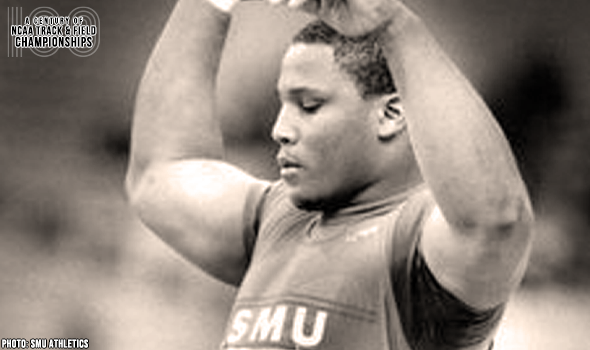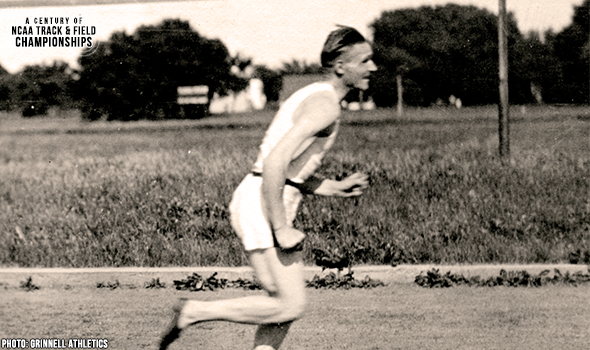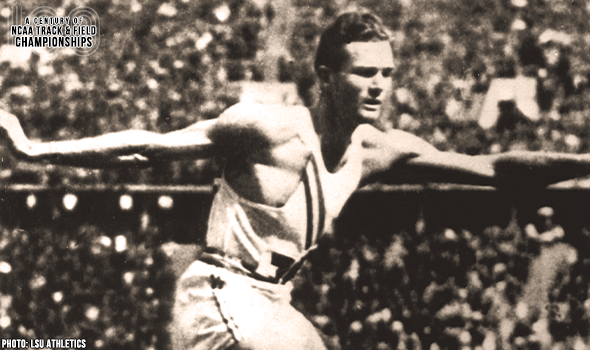
Carter’s Shot Put Prowess Was Legendary
In January 1983, Michael Carter of SMU picked up a shot for the first time in 18 months.
By June of that same year, he was looking to regain the national title in that event at the NCAA Division I Outdoor Track & Field Championships in Houston.
Carter – who had won in 1980 and 1981 – wasn’t able to try for a third in 1982 when he missed the entire indoor and outdoor seasons recovering from a football injury he suffered in October 1981. He was the starting nose tackle for the Mustangs, who were undefeated in 1982 and only lost one game in 1981.
After the cast on Carter’s right knee came off in January 1982, Carter showed his competitive side, telling John Eisenberg of the Dallas Times-Herald: “As soon as I get the go-ahead, I’m going to bust my butt like I never did before. I’m going to make my legs stronger than they ever have been.”
Meanwhile, another strong throwing figure emerged in 1982 with Carter’s absence – Oregon’s Dean Crouser, who not only won the NCAA shot that year but the discus as well. And the day before the 1983 NCAA shot final, Crouser looked great, repeating his discus win with a meet-record 65.88m (216-2) while Carter was 10th (Carter placed runner-up two years earlier in 1981).
Carter made this shot final his from the beginning. He took the immediate lead with a 20.22m (66-4¼) effort in Round 1 and then followed with the winning have of 20.90m (68-7) – his best since a pre-injury 21.25m (69-8¾) that set an NCAA Indoor meet record in 1981. Crouser, the defending champion, finished third behind John Brenner of UCLA.
As it turns out, Carter’s points were crucial to SMU, which eked out a two-point victory over Tennessee to complete a sweep of indoor and outdoor team crowns.
“I knew in the back of my mind that Crouser could hit a big one at any time,” Carter said after the meet. “I tried to improve after the second throw, but I couldn’t. I wanted to keep my string alive; my goal is eight straight.”
At this point, Carter had six national titles in the shot put – three each indoor and outdoor. He got to seven with his indoor victory in 1984, but his attempt for eight was part of an epic duel with Brenner that will be the subject of its own forthcoming moment in this series.
Alas for track & field fans, Carter’s last shot put competition came when he earned the silver medal at the Los Angeles Olympics. He then joined the NFL’s San Francisco 49ers, with whom he was part of three Super Bowl champion teams.
Michael’s two daughters also won NCAA titles – Michelle (Texas), the 2006 indoor shot put champion; D’Andra (Texas Tech), the 2009 discus champion – making the Carters the first family with three NCAA Division I track & field champions. In 2016, Michelle earned the family’s first Olympic gold medal, also becoming the first American woman to win the shot put.
The NCAA and collegiate track & field will mark a momentous milestone in the spring of 2021 -- the 100th anniversary of the NCAA Championships and with that, the NCAA Track & Field Championships. In June 1921, the University of Chicago hosted the first track & field championships in NCAA history.
This point can’t be emphasized enough: Not only was the event the first for NCAA track & field, but the first championships for any sport under the sponsorship of the NCAA.
To celebrate, over each of the next 365 days, the U.S. Track & Field and Cross Country Coaches Association (USTFCCCA) will celebrate moments, student-athletes, and coaches that have made a century’s worth of championships special. From humble beginnings to important historical milestones to the modern-day, collegiate track & field has evolved with the American society.
The 2021 edition of the NCAA Division I Outdoor Track & Field Championships begin with preliminary round action on May 27-29 in Jacksonville, Fla., and College Station, Texas. The championships final site and culmination of the celebration is slated for June 9-12, 2021 at the newly rebuilt Hayward Field in Eugene, Ore.

SIU’s Roggy Dominated The Javelin In 1978
Bob Roggy won the javelin title at the 1978 NCAA DI Outdoor T&F Championships by more than 20 feet. Roggy qualified first for the final with a MR heave of 89.30m (293‑0).

Makusha Made History In Bowerman Year Of 2011
Ngoni Makusha became just the fourth man in meet history to win individual titles in both the 100 and LJ. It was his 3rd career LJ crown and he set a CR in the 100 of 9.89.

George Mason’s Gage Shocked The NCAA LJ In 1988
Nena Gage won the long jump at the 1988 NCAA DI Outdoor T&F Championships in a shocking upset over Gail Devers.

Texas’ Thompson Marveled In NCAA Distance Events
Jerry Thompson won three career distance titles at the NCAA Outdoor T&F Championships. His first came in 1943. Then he won again in 1947 & 1948 after serving in World War II.

Grinnell’s Paulu Sprinted To NCAA History
Leonard Paulu was the first athlete to complete the 100-200 double in NCAA Outdoor Track & Field Championships history in 1922. That also made him the 1st to win back-to-back 100 titles, too.

Scott Won Back-To-Back NCAA Hammer Titles
Candice Scott won back-to-back hammer throw titles at the NCAA DI Outdoor T&F Championships in 2003 & 2004. Scott set a meet record of 69.77m (228-11) in that first year.

Drouin Soared To The Bowerman In 2013
Derek Drouin won two career HJ titles at the NCAA DI Outdoor T&F Championships. When Drouin won in 2013, he was only the fourth man to clear 2.34m (7-8) in meet history.

Watts Made Quick Work Of NCAA 400
Quincy Watts set a meet record in the 400 of 44.00 at the 1992 NCAA DI Outdoor Track & Field Championships. It lasted 25 years until 2017.

Iowa State’s Koll Rolled To 5K-10K Crowns
Lisa Koll won three career titles at the NCAA DI Outdoor T&F Championships in dominant fashion. Her average margin of victory in those 5K & 10K races was 37.73 seconds.

LSU’s Hardin Completed Unique 440-220H Double Twice
The nearly unheard of 440-220H double was so nice that Glenn Hardin did it twice! Hardin became the first to do so in meet history in 1933 and then swept them again in 1934.

